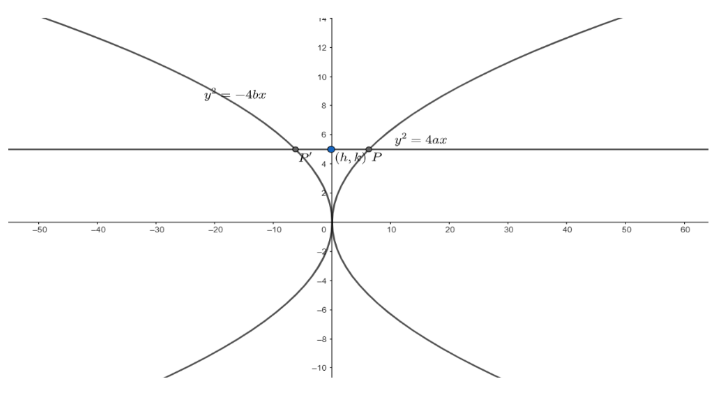
Two parabolas have a common axis and concavities in opposite directions. If any line parallel to the common axis meets the parabolas in and , prove that the locus of midpoint of is another parabola, provided that the latera recta of the given parabola are unequal.
Answer
219.3k+ views
Hint: Equation of line parallel to the common axis is given by \[y=c\].
Let’s consider the two parabolas \[{{y}^{2}}=4ax\] and \[{{y}^{2}}=-4bx\].
From the equation of the parabola, we can see that the axis of the parabolas is common and their concavities are opposite.

Now, we know the equation of the common axis is \[y=0\].
So, the equation of a line parallel to the common axis is \[y=c\].
Now, this line meets the parabolas \[{y}^{2}=4ax\] and \[{y}^{2}=-4bx\] at \[P\] and \[{{P}^{'}}\] respectively.
Let the midpoint of \[P{{P}^{'}}\] be \[\left( h,k \right)....\left( i \right)\].
Now, substituting \[y=c\] in \[{y}^{2}=4ax\], we get:
\[{{c}^{2}}=4ax\]
\[\Rightarrow x=\dfrac{{{c}^{2}}}{4a}\]
So, the point \[P\] is \[\left( \dfrac{{{c}^{2}}}{4a},c \right)\].
Substituting \[y=c\] in \[y=-4bx\], we get:
\[{{c}^{2}}=-4ax\]
\[\Rightarrow x=\dfrac{-{{c}^{2}}}{4b}\]
So, the coordinates of \[{{P}^{'}}\] are \[\left( \dfrac{-{{c}^{2}}}{4b},c \right)\].
Now, know that the coordinates of the midpoint of the line joining two points \[\left( {{x}_{1}},{{y}_{1}} \right)\] and \[\left( {{x}_{2}},{{y}_{2}} \right)\] is given as:\[\left( \dfrac{{{x}_{1}}+{{x}_{2}}}{2},\dfrac{{{y}_{1}}+{{y}_{2}}}{2} \right)\]
So, the midpoint of \[P{{P}^{'}}\] is
\[\left( \dfrac{\dfrac{{{c}^{2}}}{4a}-\dfrac{{{c}^{2}}}{4b}}{2},\dfrac{c+c}{2} \right)\]
\[=\left( \dfrac{{{c}^{2}}}{8a}-\dfrac{{{c}^{2}}}{8b},c \right)....\left( ii \right)\]
From \[\left( i \right)\]and \[\left( ii \right)\], we can conclude that
\[h=\dfrac{{{c}^{2}}}{8a}-\dfrac{{{c}^{2}}}{8b}\] and \[k=c\]
Or, \[h=\dfrac{{{k}^{2}}}{8a}-\dfrac{{{k}^{2}}}{8b}\]
Or, \[h=\dfrac{{{k}^{2}}}{8}\left( \dfrac{1}{a}-\dfrac{1}{b} \right)\]
Or, \[h=\dfrac{{{k}^{2}}}{8}\left( \dfrac{b-a}{ab} \right)\]
Or, \[\dfrac{8h\left( ab \right)}{a-b}={{k}^{2}}\]
Or \[{{k}^{2}}=\dfrac{8ab}{b-a}.h\]
Or \[{{k}^{2}}=4\left( \dfrac{2ab}{b-a} \right).h\]
Replacing \[k\] by \[y\]and \[h\] by \[x\], we get:
\[{{y}^{2}}=4\left( \dfrac{2ab}{b-a} \right).x\]
which clearly represents a parabola.
Hence, the locus of the midpoint of \[PP'\] is the parabola \[{{y}^{2}}=4\left( \dfrac{2ab}{b-a} \right).x\].
Now, in case if the latera recta of the parabolas are equal then:
We know, length of latus rectum of parabola \[{{y}^{2}}=4ax\] is \[4a\] and the length of latus rectum of parabola \[{{y}^{2}}=-4bx\] is \[4b\].
If the latera recta are equal, then
\[4a=4b\]
\[\Rightarrow a=b\]
\[\Rightarrow b-a=0\]
Now, when we substitute \[b-a=0\] in the equation of locus, we get
\[{{y}^{2}}=4\left( \dfrac{2ab}{0} \right).x\]
\[\Rightarrow {{y}^{2}}=\infty \] which is an invalid curve.
Hence, for the locus to exist, the latera recta of the two parabolas must be unequal.
So, the locus of \[P{{P}^{'}}\]is a parabola , given by \[{{y}^{2}}=4\left( \dfrac{2ab}{b-a} \right).x\], which exists only when the latera recta of the given two parabolas are unequal.
Note: Remember that the midpoint of two points \[\left( {{x}_{1}},{{y}_{1}} \right)\] and \[\left( {{x}_{2}},{{y}_{2}} \right)\]is given as \[\left( \dfrac{{{x}_{1}}+{{x}_{2}}}{2},\dfrac{{{y}_{1}}+{{y}_{2}}}{2} \right)\]. Students generally make a mistake of writing it as \[\left( \dfrac{{{x}_{1}}-{{x}_{2}}}{2},\dfrac{{{y}_{1}}-{{y}_{2}}}{2} \right)\].
Let’s consider the two parabolas \[{{y}^{2}}=4ax\] and \[{{y}^{2}}=-4bx\].
From the equation of the parabola, we can see that the axis of the parabolas is common and their concavities are opposite.

Now, we know the equation of the common axis is \[y=0\].
So, the equation of a line parallel to the common axis is \[y=c\].
Now, this line meets the parabolas \[{y}^{2}=4ax\] and \[{y}^{2}=-4bx\] at \[P\] and \[{{P}^{'}}\] respectively.
Let the midpoint of \[P{{P}^{'}}\] be \[\left( h,k \right)....\left( i \right)\].
Now, substituting \[y=c\] in \[{y}^{2}=4ax\], we get:
\[{{c}^{2}}=4ax\]
\[\Rightarrow x=\dfrac{{{c}^{2}}}{4a}\]
So, the point \[P\] is \[\left( \dfrac{{{c}^{2}}}{4a},c \right)\].
Substituting \[y=c\] in \[y=-4bx\], we get:
\[{{c}^{2}}=-4ax\]
\[\Rightarrow x=\dfrac{-{{c}^{2}}}{4b}\]
So, the coordinates of \[{{P}^{'}}\] are \[\left( \dfrac{-{{c}^{2}}}{4b},c \right)\].
Now, know that the coordinates of the midpoint of the line joining two points \[\left( {{x}_{1}},{{y}_{1}} \right)\] and \[\left( {{x}_{2}},{{y}_{2}} \right)\] is given as:\[\left( \dfrac{{{x}_{1}}+{{x}_{2}}}{2},\dfrac{{{y}_{1}}+{{y}_{2}}}{2} \right)\]
So, the midpoint of \[P{{P}^{'}}\] is
\[\left( \dfrac{\dfrac{{{c}^{2}}}{4a}-\dfrac{{{c}^{2}}}{4b}}{2},\dfrac{c+c}{2} \right)\]
\[=\left( \dfrac{{{c}^{2}}}{8a}-\dfrac{{{c}^{2}}}{8b},c \right)....\left( ii \right)\]
From \[\left( i \right)\]and \[\left( ii \right)\], we can conclude that
\[h=\dfrac{{{c}^{2}}}{8a}-\dfrac{{{c}^{2}}}{8b}\] and \[k=c\]
Or, \[h=\dfrac{{{k}^{2}}}{8a}-\dfrac{{{k}^{2}}}{8b}\]
Or, \[h=\dfrac{{{k}^{2}}}{8}\left( \dfrac{1}{a}-\dfrac{1}{b} \right)\]
Or, \[h=\dfrac{{{k}^{2}}}{8}\left( \dfrac{b-a}{ab} \right)\]
Or, \[\dfrac{8h\left( ab \right)}{a-b}={{k}^{2}}\]
Or \[{{k}^{2}}=\dfrac{8ab}{b-a}.h\]
Or \[{{k}^{2}}=4\left( \dfrac{2ab}{b-a} \right).h\]
Replacing \[k\] by \[y\]and \[h\] by \[x\], we get:
\[{{y}^{2}}=4\left( \dfrac{2ab}{b-a} \right).x\]
which clearly represents a parabola.
Hence, the locus of the midpoint of \[PP'\] is the parabola \[{{y}^{2}}=4\left( \dfrac{2ab}{b-a} \right).x\].
Now, in case if the latera recta of the parabolas are equal then:
We know, length of latus rectum of parabola \[{{y}^{2}}=4ax\] is \[4a\] and the length of latus rectum of parabola \[{{y}^{2}}=-4bx\] is \[4b\].
If the latera recta are equal, then
\[4a=4b\]
\[\Rightarrow a=b\]
\[\Rightarrow b-a=0\]
Now, when we substitute \[b-a=0\] in the equation of locus, we get
\[{{y}^{2}}=4\left( \dfrac{2ab}{0} \right).x\]
\[\Rightarrow {{y}^{2}}=\infty \] which is an invalid curve.
Hence, for the locus to exist, the latera recta of the two parabolas must be unequal.
So, the locus of \[P{{P}^{'}}\]is a parabola , given by \[{{y}^{2}}=4\left( \dfrac{2ab}{b-a} \right).x\], which exists only when the latera recta of the given two parabolas are unequal.
Note: Remember that the midpoint of two points \[\left( {{x}_{1}},{{y}_{1}} \right)\] and \[\left( {{x}_{2}},{{y}_{2}} \right)\]is given as \[\left( \dfrac{{{x}_{1}}+{{x}_{2}}}{2},\dfrac{{{y}_{1}}+{{y}_{2}}}{2} \right)\]. Students generally make a mistake of writing it as \[\left( \dfrac{{{x}_{1}}-{{x}_{2}}}{2},\dfrac{{{y}_{1}}-{{y}_{2}}}{2} \right)\].
Recently Updated Pages
The maximum number of equivalence relations on the-class-11-maths-JEE_Main

A train is going from London to Cambridge stops at class 11 maths JEE_Main

Find the reminder when 798 is divided by 5 class 11 maths JEE_Main

An aeroplane left 50 minutes later than its schedu-class-11-maths-JEE_Main

A man on the top of a vertical observation tower o-class-11-maths-JEE_Main

In an election there are 8 candidates out of which class 11 maths JEE_Main

Trending doubts
JEE Main 2026: Application Form Open, Exam Dates, Syllabus, Eligibility & Question Papers

Derivation of Equation of Trajectory Explained for Students

Hybridisation in Chemistry – Concept, Types & Applications

Understanding the Angle of Deviation in a Prism

Understanding Collisions: Types and Examples for Students

Understanding Atomic Structure for Beginners

Other Pages
JEE Advanced Marks vs Ranks 2025: Understanding Category-wise Qualifying Marks and Previous Year Cut-offs

NCERT Solutions for Class 11 Maths Chapter 10 Conic Sections

NCERT Solutions for Class 11 Maths Chapter 9 Straight Lines

NCERT Solutions For Class 11 Maths Chapter 8 Sequences And Series

How to Convert a Galvanometer into an Ammeter or Voltmeter

NCERT Solutions For Class 11 Maths Chapter 12 Limits And Derivatives




